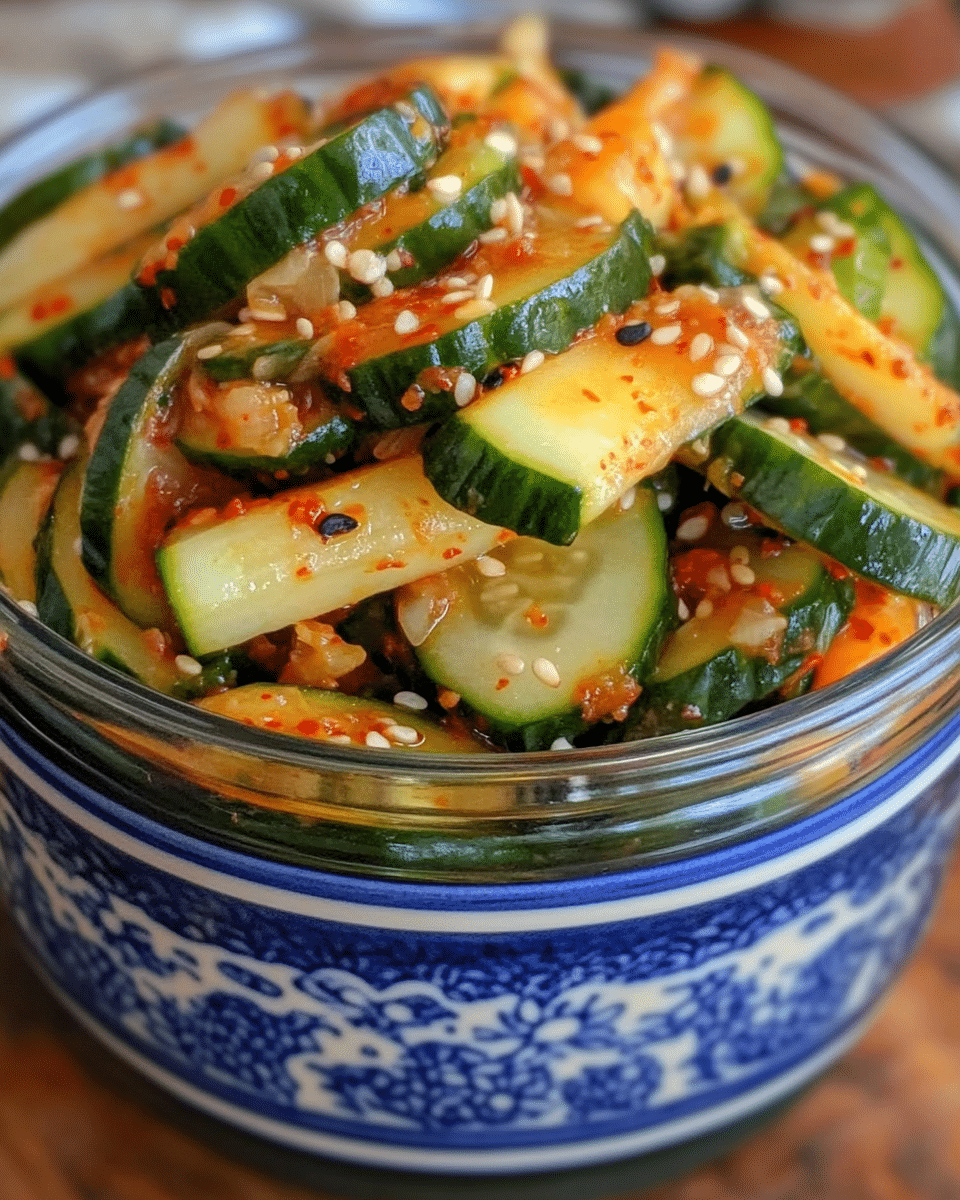Korean Cucumber Kimchi, also known as Oi Sobagi, is a delightful and refreshing side dish that bursts with vibrant flavor and texture. These crunchy cucumbers are generously stuffed with a savory mix of vegetables and spicy seasonings, creating a balance of heat, tanginess, and natural sweetness. The fermentation process enhances their probiotic benefits, making this dish as healthy as it is delicious.
Perfect as a banchan (small side dish) in Korean meals, this cucumber kimchi pairs wonderfully with grilled meats, rice bowls, or noodles. Its crisp bite and invigorating taste make it an excellent choice for hot summer days or whenever you crave a palate-cleansing accompaniment. Whether you’re a kimchi beginner or a seasoned fermenter, this easy recipe will become a favorite addition to your kitchen.
Full Recipe:
Ingredients:
-
6 small Korean cucumbers (or Persian cucumbers)
-
1 tablespoon coarse sea salt
-
1 cup Korean chives, chopped
-
2 green onions, sliced thinly
-
1 medium carrot, julienned
-
1/4 cup Korean radish (mu), julienned
-
4 garlic cloves, minced
-
1 teaspoon fresh ginger, minced
-
2 tablespoons gochugaru (Korean red pepper flakes)
-
1 tablespoon fish sauce
-
1 tablespoon sugar
-
1 tablespoon toasted sesame seeds
Directions:
-
Wash cucumbers thoroughly and cut off both ends. Slice each cucumber lengthwise into quarters, stopping about 1/2 inch from the bottom to keep them attached.
-
Sprinkle sea salt between the cucumber slits and all over the outside. Let them rest for 30 minutes to draw out moisture. Rinse and drain well.
-
In a mixing bowl, combine chives, green onions, carrot, radish, garlic, ginger, gochugaru, fish sauce, sugar, and sesame seeds to make the filling mixture.
-
Carefully stuff each cucumber with the seasoned vegetable mixture, packing generously between the slits.
-
Place the stuffed cucumbers in an airtight container and let ferment at room temperature for 1-2 days. Store in the fridge and consume within a week for best flavor.
Prep Time: 20 minutes | Fermentation Time: 1-2 days | Total Time: 1-2 days | Kcal: 45 kcal per serving | Servings: 6 servings
Korean Cucumber Kimchi (Oi Sobagi): A Tangy, Crunchy, and Refreshing Side Dish Perfect for Every Meal
Korean cuisine is beloved worldwide for its complex flavors, bold seasoning, and health benefits, and among the many iconic dishes from Korea, kimchi reigns supreme. But while most people are familiar with napa cabbage kimchi, there’s an equally delicious and refreshing variation that deserves attention: Korean Cucumber Kimchi, or Oi Sobagi (오이소박이).
Oi Sobagi is a vibrant, spicy, and tangy fermented dish made by stuffing cucumbers with a mixture of Korean chives, garlic, chili flakes, and sometimes carrots and radishes. The result is a crisp, slightly spicy, and umami-packed side dish that complements rice dishes, grilled meats, noodles, and soups. If you’re looking to make a quick kimchi that doesn’t require weeks of fermentation like cabbage kimchi, cucumber kimchi is your best friend—it’s ready to eat in a day or two and stays fresh in the fridge for about a week.
In this article, you’ll learn everything you need to know about Korean Cucumber Kimchi, its background, flavor profile, nutritional value, variations, tips for success, and why it deserves a spot on your dining table.
The Origin and Popularity of Oi Sobagi
Korea’s long history of fermenting vegetables has led to the creation of countless kimchi varieties. Oi Sobagi originated as a seasonal kimchi, popular in the late spring and summer when cucumbers are fresh, plentiful, and crisp. Unlike other types of kimchi, Oi Sobagi does not need extended fermentation; in fact, it tastes best when slightly fermented to retain the cucumbers’ crisp texture.
The word “Oi” means cucumber, and “Sobagi” means stuffed. This dish is traditionally served as a side dish or banchan in Korean households, offering a refreshing and crunchy contrast to the heavier and often oily main courses. Because of its clean, sharp flavor and cooling properties, Oi Sobagi is especially beloved during Korea’s hot summer months.
The Unique Flavor Profile of Korean Cucumber Kimchi
Oi Sobagi is famous for its perfect balance of textures and flavors:
-
Crunchy and Juicy: The salted cucumbers remain crisp while absorbing the delicious flavors of the stuffing.
-
Spicy and Tangy: Thanks to Korean red pepper flakes (gochugaru) and fish sauce (or soy sauce for vegan versions), the stuffing has a rich umami depth and gentle heat.
-
Aromatic: Fresh garlic, ginger, and chives add earthy and pungent notes.
-
Slightly Sweet: A pinch of sugar balances out the heat and acidity, bringing harmony to every bite.
The result is a refreshing yet bold side dish that enlivens rice dishes, stews, and grilled proteins, making it an indispensable part of a Korean meal spread.
Why You Should Make Cucumber Kimchi at Home
While store-bought kimchi options are more widely available today, homemade Oi Sobagi is on a different level. Here’s why:
-
Freshness Control: Homemade cucumber kimchi is crispier and fresher than any packaged variety.
-
Adjustable Flavor: Control the spice, sweetness, or saltiness according to your taste preferences.
-
Probiotic Benefits: When made without pasteurization (like all homemade versions), cucumber kimchi is rich in gut-friendly probiotics.
-
Quick Fermentation: Unlike napa cabbage kimchi that requires weeks, Oi Sobagi is ready in just 1-2 days.
-
Low Calorie & Vegan-Friendly: Naturally low in calories, gluten-free, and easily made vegan by omitting fish sauce or using plant-based alternatives.
-
Versatile: Eat as a side, as a topping for rice bowls, inside sandwiches, or wrapped in seaweed.
Nutritional Benefits of Korean Cucumber Kimchi
Kimchi in any form is celebrated for its health benefits, and cucumber kimchi is no exception. Here’s why it’s great for you:
-
Low in Calories: Cucumbers are over 90% water, making them low in calories but filling, perfect for weight management.
-
Rich in Fiber: The vegetables in the stuffing (like carrots and radish) and cucumbers themselves are packed with dietary fiber for healthy digestion.
-
Probiotic Power: The fermentation process promotes the growth of healthy bacteria (lactobacillus), essential for gut health, immunity, and even mood regulation.
-
Loaded with Vitamins: Cucumbers provide vitamin K, and the garlic and ginger are anti-inflammatory and immune-boosting.
-
Heart Healthy: Garlic, ginger, and chili flakes can reduce inflammation and improve heart health.
With no artificial preservatives or hidden additives, homemade Oi Sobagi ensures that you get clean, wholesome nutrition in every bite.
Tips for Making the Best Oi Sobagi at Home
To guarantee success with this dish, keep these helpful tips in mind:
-
Choose the Right Cucumbers: Korean cucumbers or Persian cucumbers are best. They’re thin-skinned and crunchier. If unavailable, use English cucumbers but avoid thick-skinned ones like American slicers.
-
Salt Thoroughly: Proper salting ensures the cucumbers release water, remain crisp, and absorb the stuffing flavors.
-
Use Fresh Ingredients: Fresh chives, carrots, garlic, and ginger make a noticeable difference in the final taste.
-
Don’t Overferment: Oi Sobagi should taste fresh and crisp. Check after 1-2 days and store in the fridge promptly.
-
Vegan Option: Replace fish sauce with soy sauce or tamari for a completely vegan version.
-
Add Extra Heat: Love spice? Increase the gochugaru or add a sliced fresh chili pepper to the filling.
-
Storage: Always store in an airtight container in the fridge to preserve texture and prevent over-souring.
Fun Variations of Korean Cucumber Kimchi
Want to experiment? Try these fun variations:
-
Seafood Oi Sobagi: Add tiny salted shrimp (saeujeot) for a traditional seafood umami boost.
-
Fruit-Infused Kimchi: Add thin apple or pear slices for a touch of sweetness and crunch.
-
Herb-Enhanced: Mix in fresh perilla leaves or cilantro for added aroma and depth.
-
Tofu-Style Stuffing: Add crumbled soft tofu into the stuffing mix for a creamy and protein-rich twist.
-
Spicy Garlic Oi Sobagi: Double the garlic and chili flakes for extra punch!
Each version opens new possibilities while staying true to the original Korean essence.
Pairing Suggestions for Oi Sobagi
Oi Sobagi is incredibly versatile. Here are delicious ways to enjoy it:
-
With Steamed Rice: The spice and tang beautifully contrast plain steamed rice.
-
Alongside Korean BBQ: Cuts through the richness of fatty meats like bulgogi or samgyeopsal.
-
As a Topping: Great on bibimbap (Korean rice bowls) or even in non-traditional fusion tacos.
-
With Noodles: Serve with cold noodles like naengmyeon for a refreshing summer meal.
-
Snack On Its Own: Enjoy straight from the jar for a crisp, spicy, low-calorie snack.
Conclusion
Korean Cucumber Kimchi (Oi Sobagi) is much more than just a side dish, it’s a celebration of flavor, texture, and health. Whether you’re an experienced kimchi maker or a complete beginner, this recipe offers an easy entry point into the world of Korean fermentation. Ready in just a day or two, Oi Sobagi provides the crispness of fresh cucumber with the bold, spicy, and aromatic complexity of traditional kimchi.
This dish is perfect for summertime gatherings, potlucks, or as a homemade probiotic boost to your daily meals. It’s light yet satisfying, healthy yet indulgent in taste, and versatile enough to accompany both traditional Korean spreads and fusion creations.
By learning to make this at home, you can tailor its spice, tang, and seasoning to your liking, ensuring every batch is just right for your taste buds. Plus, the health benefits from gut-friendly probiotics to immune-boosting garlic, make it a must-have in any health-conscious kitchen.
So next time you crave a zesty, refreshing side that lifts your entire meal, reach for Korean Cucumber Kimchi and enjoy a true taste of Korean culinary artistry in your own home.






